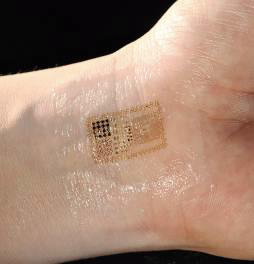EMBARGOED FOR RELEASE | March 26, 2012
New “electronic skin” patches monitor health wirelessly
Note to journalists: Please report that this research was presented at a meeting of the American Chemical Society
A press conference on this topic will be held at 1:30 p.m. Eastern Time, March 26, 2012, in the ACS Press Center, Room 15A, in the San Diego Convention Center. Reporters can attend in person or access live audio and video of the event and ask questions at www.ustream.tv/channel/acslive.
SAN DIEGO, March 26, 2012 — Like the colorful temporary tattoos that children stick to their arms for fun, people may one day put thin “electronic skin” patches onto their arms to wirelessly diagnose health problems or deliver treatments. A scientist reported on the development of “electronic skin” that paves the way for such innovations today at the 243rd National Meeting & Exposition of the American Chemical Society (ACS), the world’s largest scientific society.
Media Contact
During the meeting, March 23-28, the contacts can be reached at 619-525-6268.
Michael Bernstein
202-872-6042
m_bernstein@acs.org
Michael Woods
202-872-6293
m_woods@acs.org
John Rogers, Ph.D., said the patches have the potential to eliminate the need for patients to stay tethered to large machines in a doctor’s office or hospital room for hours of treatment or monitoring. Each year, hundreds of thousands of patients worldwide have electroencephalograms, electrocardiograms and electromyograms to check the health of their brains, hearts or muscles.
The procedures are uncomfortable, Rogers explained, with patients hooked to machines by cumbersome wires or pins adhering to the skin with gels or tape that can be painful to remove and can leave a sticky residue. More importantly, the tests detect brain, heart and muscle activity while patients are in a medical setting, rather than carrying out activities of everyday life.
“A key feature of our epidermal electronics is its natural interface to the body, without wires, pins, adhesives or gels, to allow a much more comfortable and functional system,” said Rogers. “The technology can be used to monitor brain, heart or muscle activity in a completely noninvasive way, while a patient is at home.”
The electronic skin patches are about the thickness of a human hair, and wearers can’t feel them on their skin. They could even be covered up with a real temporary tattoo. Despite their miniscule dimensions, the patches can pack full-scale electronic circuits needed to monitor health status with wireless capabilities that can, with future development, be used to transmit data to the patient’s cell phone and on to the doctor’s office.
Rogers and colleagues at the University of Illinois at Urbana-Champaign developed the patches to not only be flexible, but stretchable to move with the natural motions of the skin as people go about their normal business. This was a big challenge, however. Silicon-based wafers are typically used for electronics, such as laptops and smartphones. But these wafers are hard and brittle, like glass. To get these onto a material that bends and stretches like skin or rubber, they had to use very small pieces in a wavy pattern. “We had to structure the system in a strategic way that would avoid any strains or stresses that would crack or fracture these tiny bits of silicon,” Rogers explained.
The patches are transferred to the skin just like a temporary tattoo, with water and a backing that peels off. The first versions wore off after a day or sooner if they got wet. The latest version is applied in the same way, but a modified form of the spray-on bandages sold in drugstores is applied over the patch. The spray protects the circuit from water and normal wear-and-tear and keeps it on the skin for up to a week. In this format, the devices can accommodate transpiration, sweat and even washing with soapy water.
“We’ve also figured out how to make the devices operate in a bi-directional way,” Rogers explained. “The older devices only measure what’s going on in the body. Our newest patch can measure muscle activity and stimulate the muscles. That’s useful for rehabilitation after an accident or long periods of bed rest or even for helping people move prosthetic limbs more easily.” And with plans to add Wi-Fi capabilities, electronic skin could also send information back to a physician.
A company Rogers co-founded called mc10 is going a step further and putting the patches on medical instruments that go inside the body, such as catheters, which are balloon-like tubes used in heart surgery. The electronic skin patch is placed on the outside surface of the catheter. When the catheter expands in the heart, the patch expands with it and touches the inside of the heart, taking measurements used to guide surgery.
Rogers said the patches also could have applications in other areas useful for the consumer. For example, new devices allow monitoring and depth-profiling of skin hydration, with relevance in sports, skin-care and cosmetics, alike.
To automatically receive news releases from the American Chemical Society contact newsroom@acs.org.
###

medical care.

